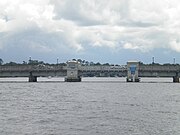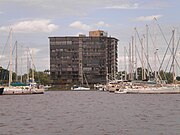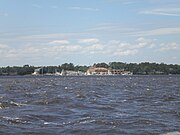
Jacksonville is a city located on the Atlantic coast of northeastern Florida, the most populous city proper in the state and the largest city by area in the contiguous United States as of 2020. It is the seat of Duval County, with which the City of Jacksonville consolidated in 1968.
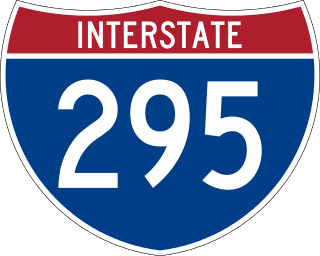
Interstate 295 (I-295), an auxiliary route of I-95, is a beltway around central Jacksonville, Florida, United States. The 61.04-mile-long (98.23 km) beltway consists of two segments, the West Beltway and the East Beltway, with I-95 serving as the dividing line between the two. The entire highway carries a hidden designation as SR 9A by the Florida Department of Transportation (FDOT). The West Beltway was constructed in the 1970s, with the East Beltway being built from the 1980s to the 2000s.
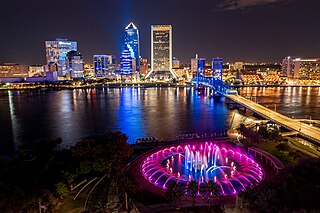
Downtown Jacksonville is the historic core and central business district (CBD) of Jacksonville, Florida. It comprises the earliest area of the city to be developed and is located in its geographic center along the narrowing point of the St. Johns River.
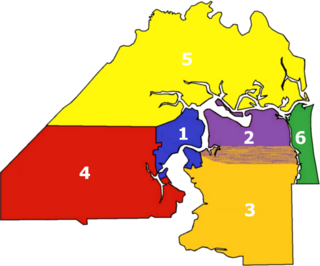
There are more than 500 neighborhoods within the area of Jacksonville, Florida, the largest city in the contiguous United States by area. These include Downtown Jacksonville and surrounding neighborhoods. Additionally, greater Jacksonville is traditionally divided into several major sections with amorphous boundaries: Northside, Westside, Southside, and Arlington, as well as the Jacksonville Beaches.

The Epping Forest was a historic, 58-acre (230,000 m2) estate in Jacksonville, Florida, United States where a luxurious riverfront mansion was built in the mid-1920s by industrialist Alfred I. du Pont and his third wife, Jessie Ball du Pont. It was added to the U.S. National Register of Historic Places in 1973 and has been restored to its original grandeur as the home of the Epping Forest Yacht Club. On April 18, 2012, the AIA's Florida Chapter placed the Epping Forest Yacht Club on its list of "Florida Architecture: 100 Years. 100 Places".

The former St. Andrew's Episcopal Church building, also known as Old St. Andrew's Event Venue, is an historic building located at 317 Florida Avenue in downtown Jacksonville, Florida. It was originally an Episcopal church, but closed when the parish relocated to the suburbs in 1960. On May 4, 1976, the edifice was added to the U.S. National Register of Historic Places. In the 1990s it was purchased by the City of Jacksonville and turned over to the Jacksonville Historical Society (JHS), and now serves as an event venue managed by the society.

State Road 134 (SR 134) is an 11-mile-long (18 km), east–west signed state highway located entirely in Jacksonville, Duval County, Florida, in the U.S. state of Florida. It extends from SR 228 to U.S. Route 17 (US 17). It is known as 103rd Street west of Wesconnett Boulevard and Timuquana Road east of the intersection. The road is between four and six lanes wide.

State Road 128 (SR 128), locally known as San Juan Avenue, is a 2.500-mile-long (4.023 km) east–west state highway in the inner urban Westside neighborhood of Jacksonville, in the U.S. state of Florida. It extends from SR 103 at its western terminus to SR 211 at its eastern terminus.
Roosevelt Boulevard is a six lane highway on the west side of Jacksonville, Florida. It takes US 17 and SR 15, from the Duval county line just south Interstate 295, until its northern end at Willow Branch Avenue, with the road itself becoming one of the incarnations of College Street in the Riverside area of Jacksonville.

Deerwood was the first gated community in Florida, US. After it was established in the mid-1960s, it was the most exclusive residential area on Jacksonville's Southside. The golf course hosted the Greater Jacksonville Open in the late 1960s and early 1970s, forerunner of The Players Championship, and was once the site of talks between President Gerald Ford and Egyptian President Anwar Sadat in November 1975.

Timuquana Country Club is a private golf and country club in Jacksonville, Florida. Located in Jacksonville's Ortega neighborhood, it was founded in 1923. Its golf course was originally designed by legend Donald Ross, and members have included PGA Tour professionals Steve Melnyk, David Duval and current member Jim Furyk. It has hosted various golf tournaments since its opening, including the 2002 United States Senior Men's Amateur Golf Championship, the United States Golf Association (USGA) U.S. Women's Amateur Four-Ball Championship in 2019, and is the host site for the PGA TOUR's Champions Constellation Furyk & Friends starting in 2021.

The Florida Yacht Club is a private country and yacht club in Jacksonville, Florida, U.S. It is the oldest social club in Jacksonville, and is the fourth oldest surviving yacht club in the U.S. It was founded in downtown Jacksonville in 1876 , and moved to its present location in the Ortega neighborhood in 1928.

Riverside and Avondale are two adjacent and closely associated neighborhoods, alternatively considered one continuous neighborhood, of Jacksonville, Florida. The area is primarily residential, but includes some commercial districts, including Five Points, the King Street District, and the Shoppes of Avondale.

Wilbur B. Talley was an architect in Florida. He worked in Jacksonville until the death of his wife Nellie and daughter Sarah, who were riding in a car hit by a train on December 21, 1919. After the accident, he moved to Lakeland, Florida where he continued working as an architect.
Mellen Clark Greeley was an American architect in Jacksonville, Florida. He was considered to be the "Dean of Jacksonville Architects".
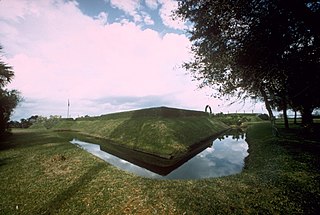
Arlington is a large region of Jacksonville, Florida, and is generally understood as a counterpart to the city's other large regions, the Urban Core, Northside, Southside, Westside, and the Beaches. It borders the Southside area at its southern end, and has several bridge connections to nearby beaches, the Northside and Downtown. The expansive neighborhood was incorporated into the city in 1968 as a result the Jacksonville Consolidation, a city-county consolidation of the governments of the City of Jacksonville and Duval County. Arlington is known for its mid-century modern architecture, and contains several architecturally significant homes designed by local architects Robert C. Broward, Taylor Hardwick, and William Morgan.
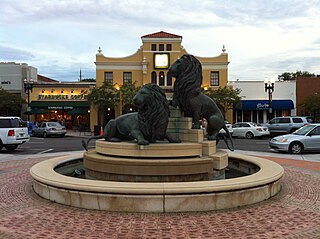
San Marco is a neighborhood of Jacksonville, Florida, south of Downtown across the St. Johns River. The neighborhood was formerly the independent city of South Jacksonville until it was annexed by Jacksonville in 1932. The neighborhood is primarily residential, with an integrated commercial sector known as San Marco Square.

The architecture of Jacksonville is a combination of historic and modern styles reflecting the city's early position as a regional center of business. According to the National Trust for Historic Preservation, there are more buildings built before 1967 in Jacksonville than any other city in Florida, though few structures in the city center predate the Great Fire of 1901. Numerous buildings in the city have held state height records, dating as far back as 1902, and last holding a record in 1981.

Laura Street is a north–south street in Jacksonville, Florida, United States, named for the daughter of the city's founder, Isaiah D. Hart. Historically, the downtown portion of Laura Street has been considered the financial district of Jacksonville.





